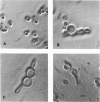Abstract
The growth of Saccharomyces cerevisiae wild-type strain X2180 in minimal medium was inhibited by the addition of higher-than-supplementary levels of alpha-aminoadipate. This inhibitory effect was reversed by the addition of arginine, asparagine, aspartate, glutamine, homoserine, methionine, or serine as single amino acid supplements. Mutants belonging to the lys2 and lys14 loci were able to grow in lysine-supplemented alpha-aminoadipate medium, although not as well as when selected amino acids were added. Growth in alpha-aminoadipate medium by all strains was accompanied by an accumulation of alpha-ketoadipate. Glutamate:keto-adipate transaminase levels were derepressed two- to fivefold in lys2 mutants using alpha-aminoadipate as a nitrogen source. Wild-type strain X2180 growing in amino acid-supplemented AA medium exhibited higher levels of alpha-aminoadipate reductase. Mutants unable to use alpha-aminoadipate without amino acid supplementation were obtained by treatment of lys2 strain MW5-64 and were shown to have glutamate: ketoadipate transaminase activity and to lack alpha-aminoadipate reductase activity. Altered cell morphologies, including increased size, multiple buds, pseudohyphae, and germ tubes, evidenced by cells grown in alpha-aminoadipate medium suggest that higher-than-supplementary levels of alpha-aminoadipate result in an impairment of cell division.
Full text
PDF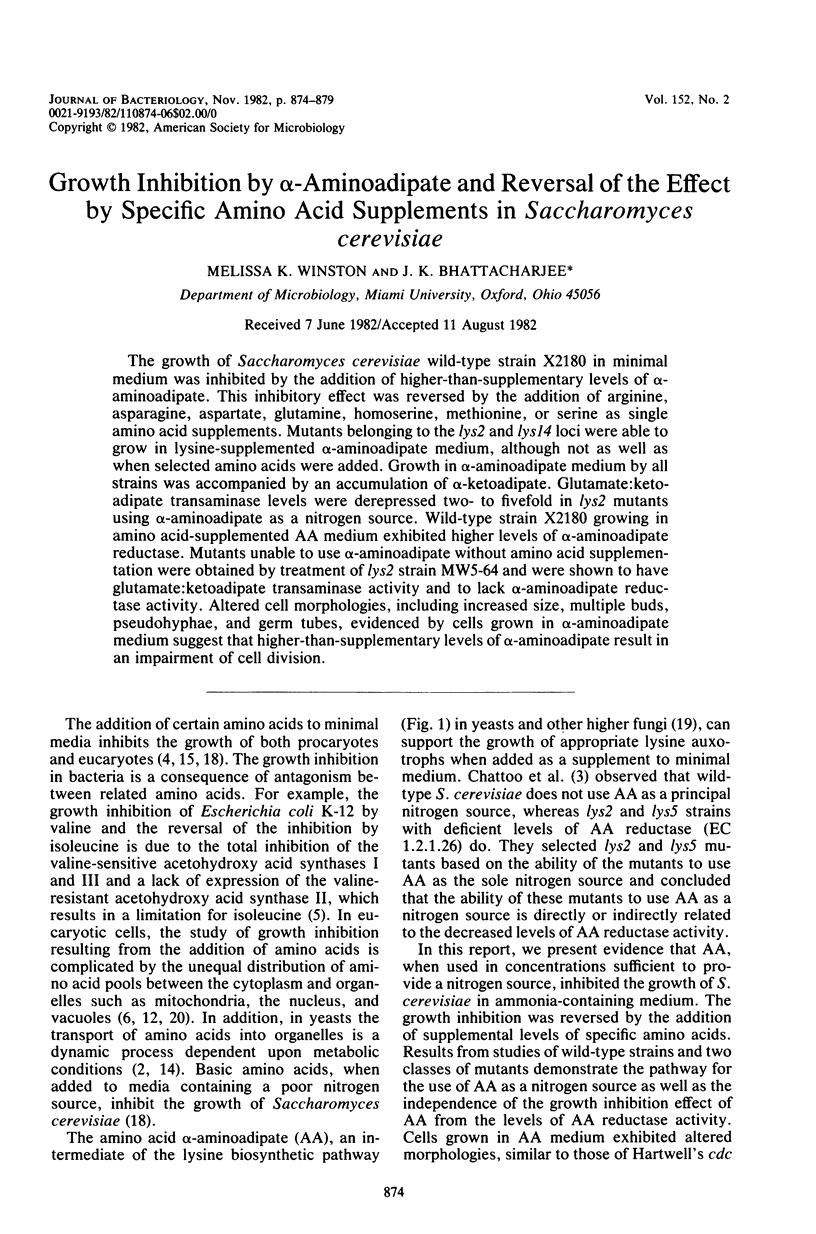
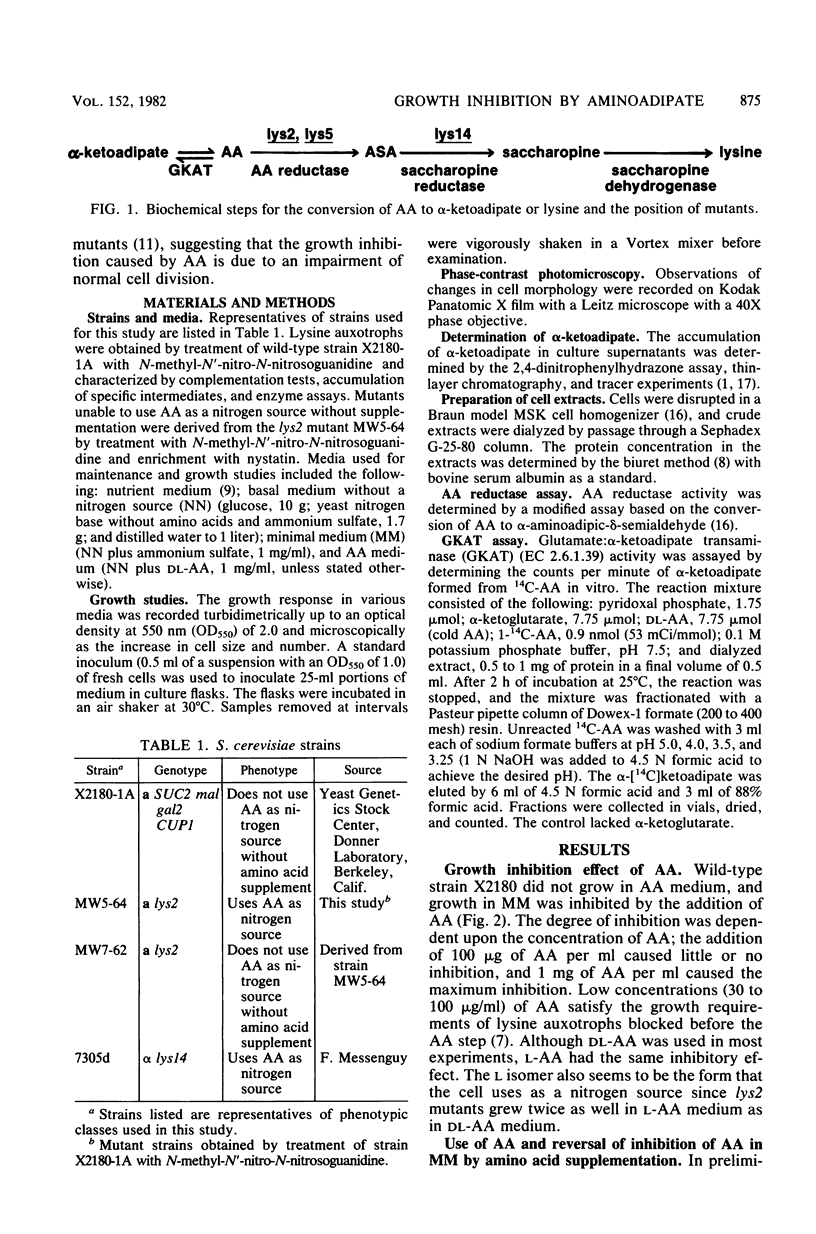
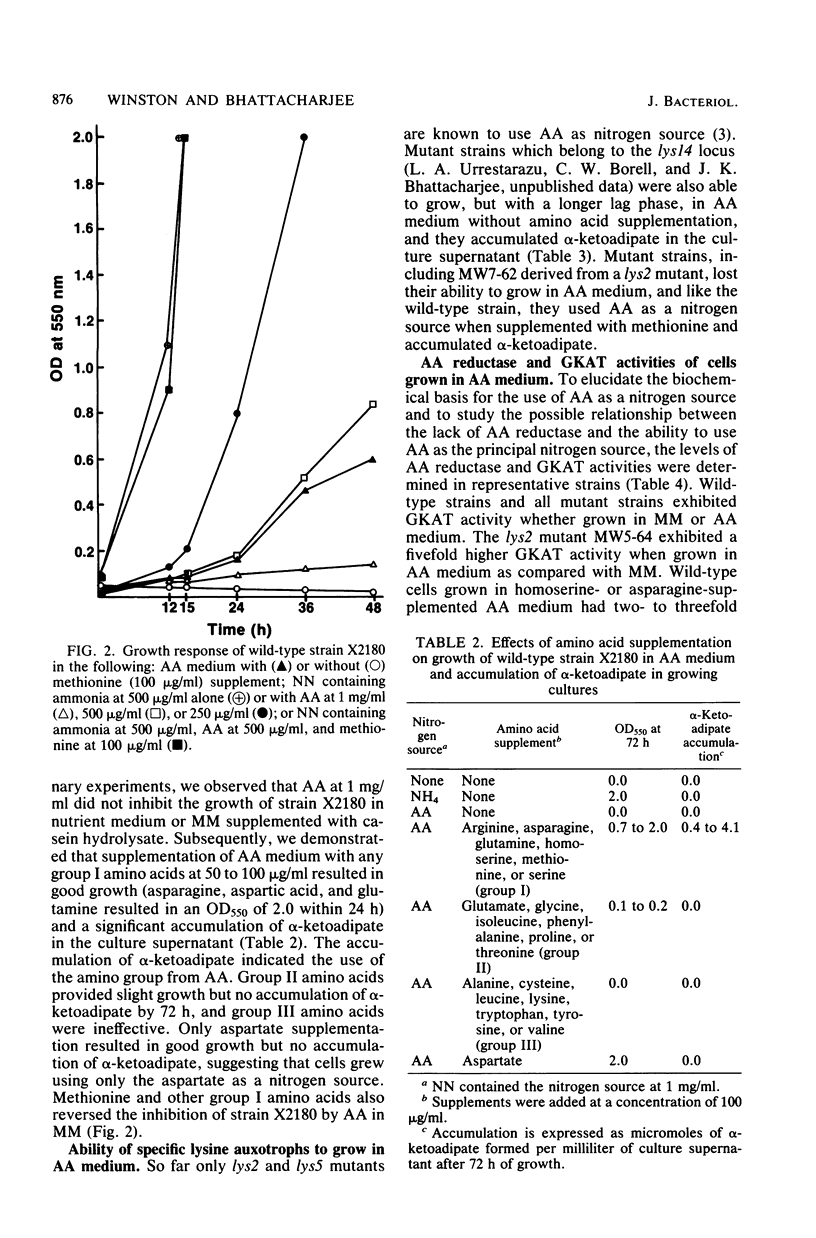
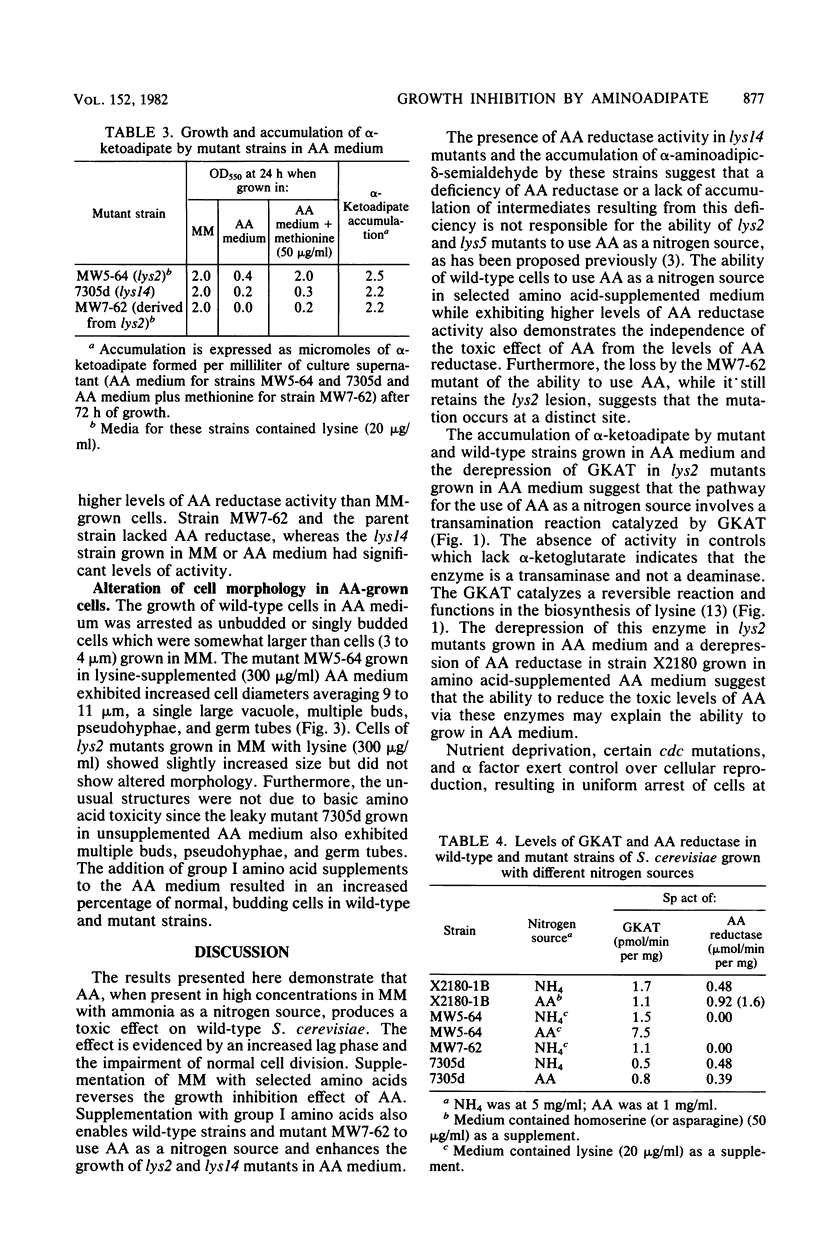
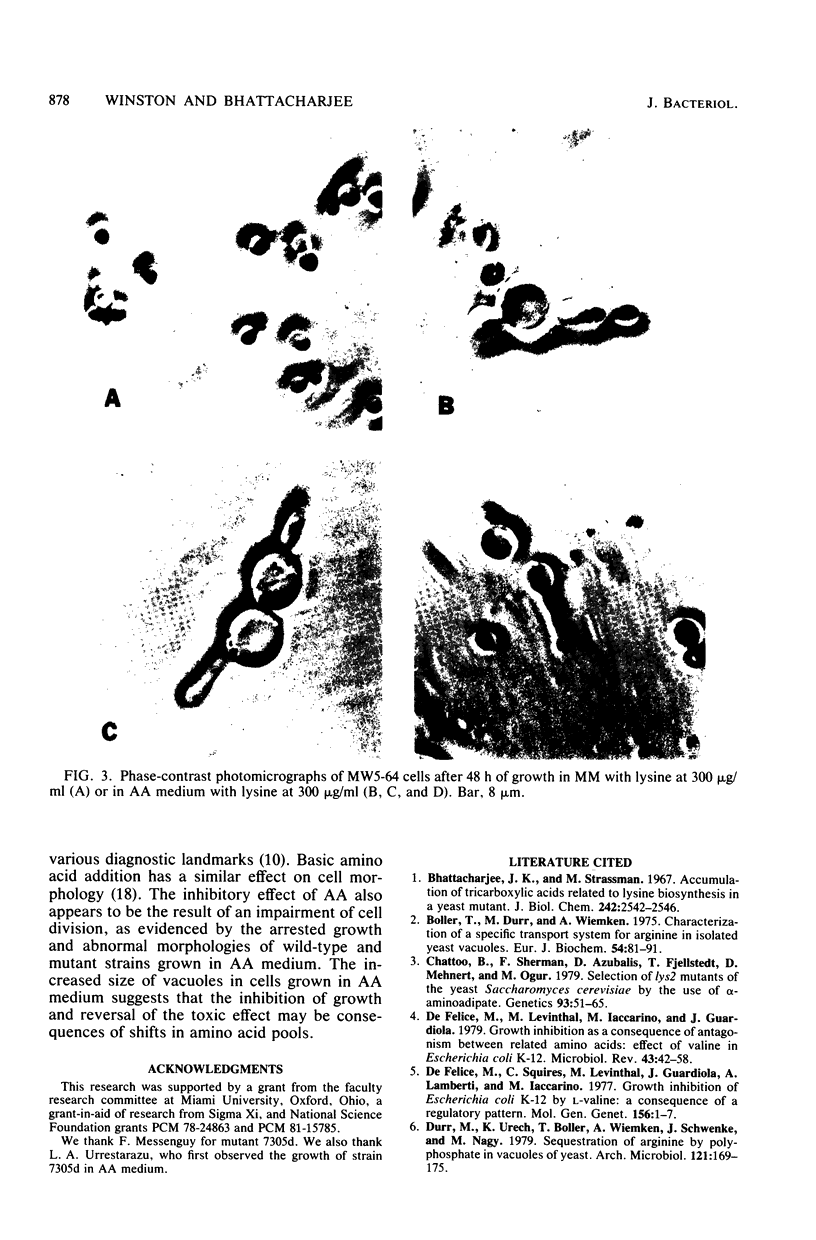
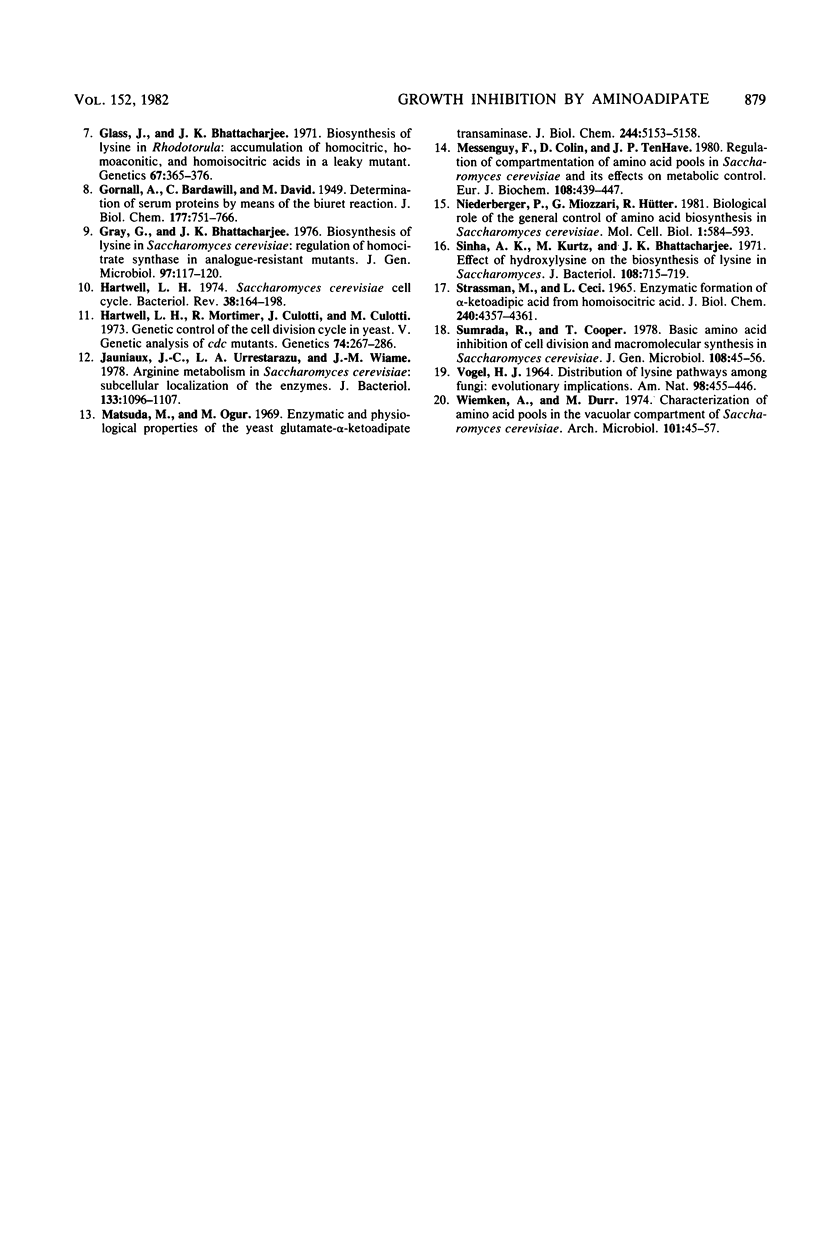
Images in this article
Selected References
These references are in PubMed. This may not be the complete list of references from this article.
- Bhattacharjee J. K., Strassman M. Accumulation of tricarboxylic acids related to lysine biosynthesis in a yeast mutant. J Biol Chem. 1967 May 25;242(10):2542–2546. [PubMed] [Google Scholar]
- Boller T., Dürr M., Wiemken A. Characterization of a specific transport system for arginine in isolated yeast vacuoles. Eur J Biochem. 1975 May;54(1):81–91. doi: 10.1111/j.1432-1033.1975.tb04116.x. [DOI] [PubMed] [Google Scholar]
- Chattoo B. B., Sherman F., Azubalis D. A., Fjellstedt T. A., Mehnert D., Ogur M. Selection of lys2 Mutants of the Yeast SACCHAROMYCES CEREVISIAE by the Utilization of alpha-AMINOADIPATE. Genetics. 1979 Sep;93(1):51–65. doi: 10.1093/genetics/93.1.51. [DOI] [PMC free article] [PubMed] [Google Scholar]
- De Felice M., Levinthal M., Iaccarino M., Guardiola J. Growth inhibition as a consequence of antagonism between related amino acids: effect of valine in Escherichia coli K-12. Microbiol Rev. 1979 Mar;43(1):42–58. doi: 10.1128/mr.43.1.42-58.1979. [DOI] [PMC free article] [PubMed] [Google Scholar]
- De Felice M., Squires C., Levinthal M., Guardiola J., Lamberti A., Iaccarino M. Growth inhibition of Escherichia coli K-12 by L-valine: a consequence of a regulatory pattern. Mol Gen Genet. 1977 Nov 4;156(1):1–7. doi: 10.1007/BF00272245. [DOI] [PubMed] [Google Scholar]
- Glass J., Bhattacharjee J. K. Biosynthesis of lysine in Rhodotorula: accumulation of homocitric, homoaconitic, and homoisocitric acids in a leaky mutant. Genetics. 1971 Mar;67(3):365–376. doi: 10.1093/genetics/67.3.365. [DOI] [PMC free article] [PubMed] [Google Scholar]
- Gray G. S., Bhattacharjee J. K. Biosynthesis of lysine in Saccharomyces cerevisiae: regulation of homocitrate synthase in analogue-resistant mutants. J Gen Microbiol. 1976 Nov;97(1):117–120. doi: 10.1099/00221287-97-1-117. [DOI] [PubMed] [Google Scholar]
- Hartwell L. H., Mortimer R. K., Culotti J., Culotti M. Genetic Control of the Cell Division Cycle in Yeast: V. Genetic Analysis of cdc Mutants. Genetics. 1973 Jun;74(2):267–286. doi: 10.1093/genetics/74.2.267. [DOI] [PMC free article] [PubMed] [Google Scholar]
- Hartwell L. H. Saccharomyces cerevisiae cell cycle. Bacteriol Rev. 1974 Jun;38(2):164–198. doi: 10.1128/br.38.2.164-198.1974. [DOI] [PMC free article] [PubMed] [Google Scholar]
- Jauniaux J. C., Urrestarazu L. A., Wiame J. M. Arginine metabolism in Saccharomyces cerevisiae: subcellular localization of the enzymes. J Bacteriol. 1978 Mar;133(3):1096–1107. doi: 10.1128/jb.133.3.1096-1107.1978. [DOI] [PMC free article] [PubMed] [Google Scholar]
- Matsuda M., Ogur M. Enzymatic and physiological properties of the yeast glutamate-alpha-ketoadipate transaminase. J Biol Chem. 1969 Oct 10;244(19):5153–5158. [PubMed] [Google Scholar]
- Messenguy F., Colin D., ten Have J. P. Regulation of compartmentation of amino acid pools in Saccharomyces cerevisiae and its effects on metabolic control. Eur J Biochem. 1980 Jul;108(2):439–447. doi: 10.1111/j.1432-1033.1980.tb04740.x. [DOI] [PubMed] [Google Scholar]
- Niederberger P., Miozzari G., Hütter R. Biological role of the general control of amino acid biosynthesis in Saccharomyces cerevisiae. Mol Cell Biol. 1981 Jul;1(7):584–593. doi: 10.1128/mcb.1.7.584. [DOI] [PMC free article] [PubMed] [Google Scholar]
- Sinha A. K., Kurtz M., Bhattacharjee J. K. Effect of hydroxylysine on the biosynthesis of lysine in saccharomyces. J Bacteriol. 1971 Nov;108(2):715–719. doi: 10.1128/jb.108.2.715-719.1971. [DOI] [PMC free article] [PubMed] [Google Scholar]
- Strassman M., Ceci L. N. Enzymatic formation of alpha-ketoadipic acid from homoisocitric acid. J Biol Chem. 1965 Nov;240(11):4357–4361. [PubMed] [Google Scholar]
- Sumrada R., Cooper T. G. Basic amino acid inhibition of cell division and macromolecular synthesis in Saccharomyces cerevisiae. J Gen Microbiol. 1978 Sep;108(1):45–56. doi: 10.1099/00221287-108-1-45. [DOI] [PubMed] [Google Scholar]
- Wiemken A., Dürr M. Characterization of amino acid pools in the vacuolar compartment of Saccharomyces cerevisiae. Arch Microbiol. 1974;101(1):45–57. doi: 10.1007/BF00455924. [DOI] [PubMed] [Google Scholar]



